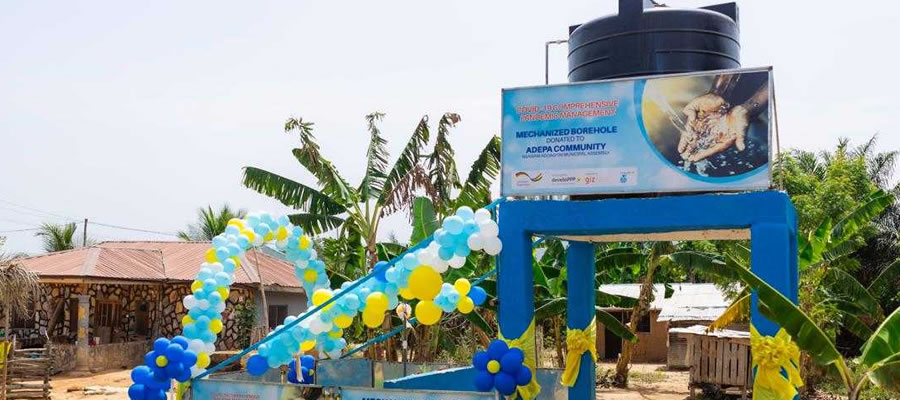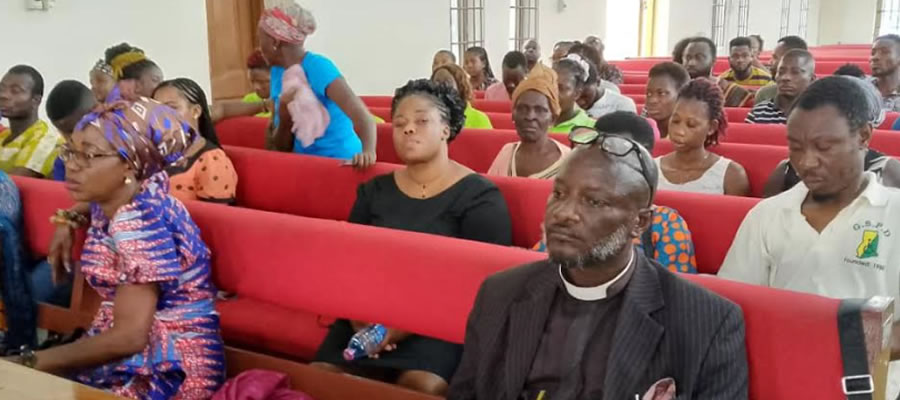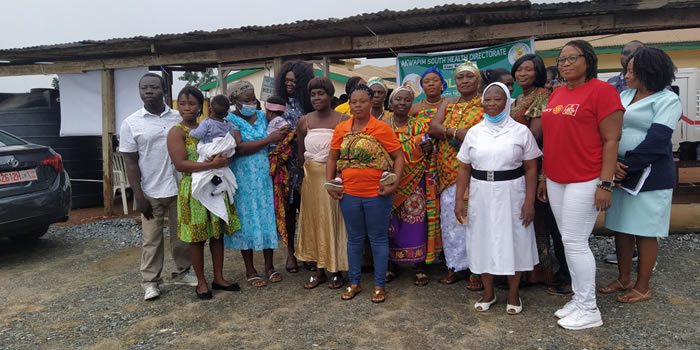

Vulnerability Analysis, Exclusion and Empowerment
Vulnerability connotes people in a given local setting, who are most likely to fall through the cracks of regular programmes, policies and traditional safety nets and therefore need to be given special attention when programmes and policies are designed and implemented (Anne Kielland and the World Bank’s OVC Thematic Group, 2004).
Vulnerability in the Akwapim South District would be considered to all but not limit to the following: Risks and shocks; Child poverty; Orphans; Child abuse and victims of abuse; Child trafficking; People in disaster prone zones; Persons with disabilities; and Child labour.
The vulnerable and excluded in the District include the disabled, peasant farmers, the aged, rural women and children, people living with HIV/AIDS, orphans and homeless children. Peasant farmers are the most vulnerable of all farmers especially the majority who depend on rainfall for production. This situation, coupled with the increasing loss of farmlands represents dominant shocks that affect incomes, availability of food and wealth accumulation. Children and other dependents find themselves in difficult situations because of these shocks.
Besides these, some children find themselves in difficult circumstances because of the following shocks: death of parents, abandonment and separation due to mental problems of parents. Children living and working on the street are engaged in trading activities, which includes selling ice water and chewing gums, head portage (kayayo), truck pushers and working as driver’s mates. These are mostly found in the district capital and some troop to Madina. In the rural areas however, children are engaged in hazardous work such as stone quarrying farming activities. These negatively affect their physical, educational and mental development.
In addition to the above, the aged, HIV/AIDS infected and affected, street children and the disabled are left without or with very little safety nets. This situation calls for appropriate strategies to cover their needs. Adequate and disaggregated data on the vulnerable in the district need to be collected, analyzed and the appropriate inter-sectorial interventions implemented to mitigate the impact of the shocks.
In summary, the following groups of people are classified vulnerable and excluded in the district based on the following:
· Persons with Disability
· Stigmatization of HIV Patients
· Victims of Abuse
· Low self esteem
· Stigmatization
· Women
· Bounded by customs and traditions
· Poverty( inadequate capital to start and expand their businesses)
· Children
· Malnutrition as a result of poverty and their large numbers at home
· Few of them are under child labour (thosein the rural areas)
· Aged
· Loneliness as a result of childlessness
· Failure in implementation of the disability laws made nationwide and
locally
The entire group has resulted into serious social problem in the district and it requires an integrative approach to overcome it,
hence it leads to the following problems;
· High influx of unskilled youth to the urban centres
· Incidence of child abuse/street children in the urban centres
· Lack of comprehensive data on the vulnerable in the society, and thus lead to inadequate
intervention
· Slow pace of integrating people with disabilities into the main-stream or development
· Unsatisfactory operations of some day care centres due to increased numbers.
Persons with Disability
A person is physically challenged because of a physical, intellectual or sensory impairment; he or she is denied the opportunities available in the community. In addition, disability is the inability of at least one part of the body to function properly. According to the 2010 population and housing census, 5.4 percent of the total population of Akwapim South District suffers from various forms of disability. These include the following;
· Physical Disability: This refers to problems affecting how the body works or moves
· Hearing Disability: This is the partial or total deafness and speech problems
· Visual Disability: This is the partial or total loss of sight or blindness
Barriers Faced by Physically Challenged that Make them Vulnerable
Environmental Barriers:
These are physical barriers that effect persons with disability in the district. These include unfriendly public transport facilities, public building/facilities, pedestrian streets, offices and factories, places of worship, access to information among others.
Attitudinal Barriers:
These are less obvious from the above, but they can inhibit the disabled from achieving daily ideas. The persons with disability are automatically assumed incapable, embittered, tragedy-stricken, in need of cure, of low intelligence and aggressive.
Institutional Barriers:
The physically challenged are excluded under this in many areas of society. These institutions include the family, religion, education, health service, social services, class system, employment and political system.
Issues on Child Welfare
Children cover boys and girls between the ages of 0 and 14 years, according to the United Nations definition for children. However, Ghana recognizes the age cohorts of 0 – 18 to cover children. Children are generally classified as vulnerable in most instances because they are the most affected in the home and community, whenever there is violence, assaults, broken homes and other forms of abuses, risks and shocks.
Women Empowerment
Participation of women in the political life of the District is not encouraging. Currently, there are only four (4) Assemblywomen, of which three (3) are government appointees to the assembly. Considering the role women play in both the local and national economy, the low participation of women in the decision making process of the District means that their views would not be fully reflected in development activities, and this has serious implication for the overall development of the District.
Programmes Organized for the Vulnerable
There are national programmes and other programmes organized for the vulnerable groups at the district level to ensure the development and welfare of the vulnerable groups in the district.
The programmes are providing support and influence much to reduce the intensity of vulnerability in the district. By 2017, the outlined are the identified programmes in the district:
· Livelihood Empowerment Against Poverty (LEAP) - 14 communities of a total of 342 deprived and under privileged
households benefit from the programme comprising of 1,080 individuals with 480 males and 1,000 females.
· Skills training for 320 Persons with Disability in soap making and others
· Educating the Public on the need to maintain and enroll their children in school
· Ensure that all children are registered under the N.H.I.S
· Educating the populace on the consequences of child abuse, child labour and child trafficking.
· Educate the men on the need to accord women necessary respect and support.
· Education on political, socio economic and family welfare issues for women’s group in the district – Hairdressers, d
ressmakers, market women, churches and school.
General Problems that Face the Vulnerable in the District
The under listed are problems identified that affect the vulnerable and excluded in the district:
1. Inadequate financial support from the common fund
The need to satisfy the numerous needs of the district with the limited funds of the Assembly affects the limited budgetary allocation towards the development of the vulnerable groups in the district.
2. Discrimination and Stigmatization
Discrimination is the prevention of a person or group of people from participating in an activity, agenda or programme. The vulnerable groups are mostly eliminated from participating in activities such as decision-making, some aspects of economic activities and enjoying some basic rights in society. The perception and notions associated with the vulnerable groups in the form of stigmatization do not encourage the group to involve in some economic activities that will enhance their welfare. The problem also limits the vulnerable groups from enjoying some basic
rights in the district. The situation makes them more vulnerable and excluded in the total development of the district.
3. Low or no support from family
Most of the vulnerable especially the physically challenged face the problem of being neglected by their families. The situation has found most them on streets begging for their livelihood. This further exposes them to more risk and endanger their lives.
Proposed measures for solving the Problems
The district Assembly has put in place some measures in place to solve the problems the vulnerable and excluded face in the district. Below are identified measures:
· Social education (sensitization on stigmatization)
· Encouraging parents to send their physically challenged children to school
· Provide the vulnerable groups with employable skills
Date Created : 2/20/2020 3:32:35 AM











 facebook
facebook
 twitter
twitter
 Youtube
Youtube
 +233 593 831 280
+233 593 831 280 0800 430 430
0800 430 430 GPS: GE-231-4383
GPS: GE-231-4383 info@ghanadistricts.com
info@ghanadistricts.com Box GP1044, Accra, Ghana
Box GP1044, Accra, Ghana